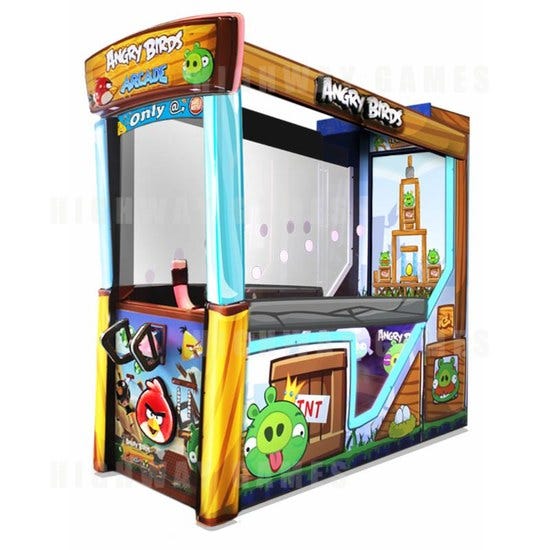Defender dev Eugene Jarvis on the bright future of arcade games
“Whenever I talk to people about arcade games, they’re shocked to know the business still exists,” Eugene Jarvis says. “I, too, am amazed. We should have packed it up in the last millennium.”

Veteran developer Eugene Jarvis recalls an incident from 1981 that perfectly encapsulates the extent that arcade games captured the youth zeitgeist of that era. “Two kids broke into a 7/11,” he says. “And instead of robbing the joint, they took quarters out of the cash register to play Defender.”
That frantic 1981 side-scrolling scifi shoot-‘em-up, co-designed by Jarvis, touched off a global sensation. It was one of the highest-grossing coin-op games of the Golden Age of Arcades. Jarvis went on to create iconic quarter-gobblers like Robotron: 2084, NARC, Smash TV, and Cruis'n.
Over 30 years later, Jarvis is still working to keep arcade games popular for a new generation of gamers.
“Whenever I talk to people about arcade games, they’re shocked to know the business still exists,” he says. “I, too, am amazed. With all the cool shit out there, we should have packed it up in the last millennium.”
Today, Jarvis leads game studio Raw Thrills. If you've encountered arcade games in the wild at a movie theater or a Dave & Buster's lately, there's an excellent chance that you've seen the company's handiwork. Recent releases include light gun games like Big Buck HD Wild and Aliens Armageddon, as well as racing games like Batman and Winter X Games SnoCross.
"The arcade remains the most primal experience. I think Trip Hawkins said it best: You’ve got to be simple, hot, and deep."
Jarvis says that the skills needed to design a great arcade game are timeless, and can be applied by devs no matter the style or genre or the method of interface.
“Arcade gaming remains the most primal experience,” Jarvis says. “I think Trip Hawkins said it best: You’ve got to be simple, hot, and deep. Simple in that it's easy to understand. Hot in that it is a compelling and exciting experience. Deep in that it goes beyond the trivial and is always challenging but never impossible, with new nuances to discover along the way.”
Jarvis' latest project is Jurassic Park Arcade, which he describes as “an amazing dinosaur love fest thriller/shooter.”

“Basically, you’re trying to put the T-rex back in the bottle, minimizing collateral damage and staying alive,” Jarvis explains. “The dinosaur animations are unprecedented in their realism—they practically drool on you!”
Despite his deep commitment to arcade games, he’s no dummy: Jarvis is well aware that the technological landscape evolves and disrupts at breakneck pace. You never know if the next innovation could turn you into a dinosaur.
“Who would have thought that Nintendo, the impervious fortress of Mario, would be laid low by millions of no-name apps on four-inch screens?” he asks.
But Jarvis argues that one of the reasons arcades have been able to survive in the iPhone age is an innate human need for connectivity—and not just in the shallow, disconnected sense of scrolling through Instagram selfies or skimming and “liking” Facebook updates. Arcade games physically require people to play face-to-face, side-by-side, in person. And not even the most intense online Call of Duty brawls with aggressive headset-wearing strangers can replace that.
"We have a primal need for meatspace interaction."
“There is a certain fatigue with 24/7 social networking with all the virtual assholes,” Jarvis says. “We don’t need a massive online social posse. We have a primal need for meatspace interaction.”
Jarvis also believes that the key appeal of mobile games is present in arcades as well. With Nintendo's recent stumbles and the rise of Steam, consoles and PCs have emerged as the exclusive domains for the committed hardcore crowd, and gaming experiences that demand a large investment of both time and money. Meanwhile, mobile and arcade gaming is where you fo for brief, inviting, accessible, inexpensive casual expereinces.
Jarvis has even been working with ICE Games on Angry Birds Arcade, mixing the very twenty-first century mobile IP with a tactile old-school feel and playstyle that throws you back to gaming’s early days.

And even as smartphones become more powerful, Jarvis belives that arcades will maintain many competitive advantages in attracting casual audiences. “That’s when we bring out our superpower: the power of real,” Jarvis says. “There’s only so much you can do in a four-inch screen that’s all virtual. We have real stuff in the arcade: Skee-ball, basketball hoops, simulators with real cockpit controls, gas pedals, real leaning bikes, force feedback. And we have the power of big: Massive sound systems, and humongous 4K screens.”
The power of bigness is the key to to yet another Jarvis project: a recently completed collaboration with Bandai Namco to put together the world’s largest Pac-Man game. Players gaze up reverently at an obelisk of old-school cool, a 10-foot screen of 64,512 discrete LEDs, which duplicate the exact 8-bit goodness of the classic, pixel by pixel.

In addition to remaining prolific, Jarvis is also extremely optimistic about the future of his corner of the industry.
“VR will be a huge growth area for the arcade,” he says. “The players are gravitating to fully immersive theatrical, interactive experiences. I think the arcade will prove to be the ideal venue for it.”
Virtual reality has been viewed with skepticism, with many saying that it will take years to become a mass market phenomenon. Jarvis views arcades’ accessibility as a way to introduced VR to the sort of people who would never dream of shelling out top dollar to acquire the powerful HMD and high-end computer hardware required to experience cutting edge VR at home. “You don't need to dedicate your life to a game," he says. "In the arcade, you can just have a few minutes of pure fun.”
About the Author(s)
You May Also Like







.jpeg?width=700&auto=webp&quality=80&disable=upscale)








